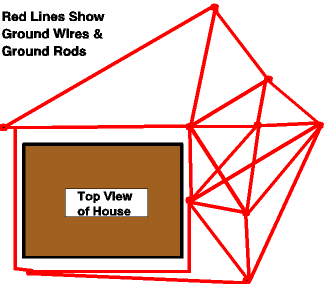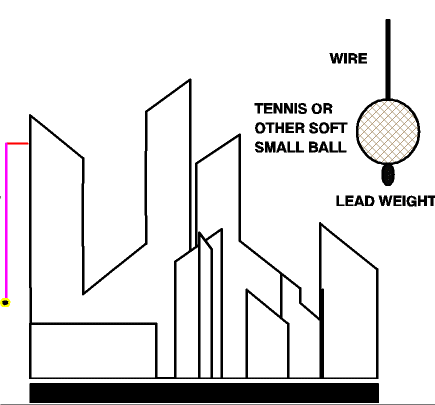Apartment & House Ground Systems
The solution in most cases of bad soil conductivity is to add more ground rods or radials or both. If you choose radials, make them random length to avoid having resonance take place on some bands. Also you can place more ground rods at the end of each radial to help even more. If you use 1/2 inch, (1.27 cm.) hard-drawn copper pipe for your ground rods, you can add a connection for a garden hose and run water down into the ground to improve conductivity. For that matter, in a past edition of antenneX, there is an article on making a water drill to help sink a ground pipe very easily in most types of soils.
In some cases, ground conductivity is so bad that installing a network of radials and ground rods is the only solution. Figure 1 illustrates one way this can be done. In most cases, this very extensive installation would not be required and a smaller one would do fine. This type of installation will reduce the effects of the dehydration of the ground during dry spells.

In one case, a local ham attached the ground system to the metal rebar in his house slab foundation. Each rebar was also wired together throughout the slab. This was in addition to the radials and ground rods he installed before his yard was put landscaped. This worked well, but is not always an option to most. The best thing most can do is install more radials and ground rods. However NEVER TIE INTO THE POWER COMPANY GROUND ROD found at your house or dwelling meter. If you do and there is a problem with their ground connection, your rig and YOU could go up in smoke. This is a WARNING THAT MUST NOT BE IGNORED. Fooling with any part of a commercial power grid should never be done and is extremely dangerous.
For apartment and condo dwellers, the problem is more complicated since newer buildings may use PVC for the water lines. If this is your situation, there are several solutions. First, you can run several lengths of wire around your apartment interior along the walls behind furniture or under carpet if you have any. Tie the wires together at the rig ground post and run them away from your rig in different directions. Be sure the bare ends of the wires are insulated in some manner, since there may be high voltage present on some bands.
Another method is to hang a weighted wire out the window when you want to get on the air. If you use a fishing weight and a tennis ball on the end of the wire, it will not make very much noise when it bumps the building in the wind. This was a trick that spies in WWII used in France and other countries. Also, it is important to dye or paint the ball a dull color and use some wire like brown or black lamp cord instead of shiny enamel coated wire. Using two-conductor lamp cord will enable you to buy half of the length needed. Then split the two conductors and solder them together giving you the length to reach the ground or to hang a weighted wire out the window. Be sure to tape up the soldered joint and seal the dangling end to keep moisture out and prevent arching. Just pick the color of cord that will blend in best with your building. Figure 2 illustrates this.

You might even be able to hide a ground wire alongside the building and tie it to a ground rod at ground level, if you are not too far above ground. If you are too high, then these methods are probably the only simple options. Connecting to radiators might cause RFI somewhere else in the building. For that matter, connecting to any thing in the building wiring, frame or plumbing is to be avoided for that matter, just for this reason. RFI is a good way to get evicted very fast.
These methods provide a counterpoise instead of a real ground, but the antenna does not know the difference. MFJ made a device that is designed to improve the action of a counterpoise by resonating it. There is also an article in a past issue of antenneX on construction of a similar device. In the past, hams and SWLs have used things like bedsprings to act as counterpoises.
One ham had twin beds and put them end to end and loaded them up as a dipole on several bands. The building was a wooden frame house that had been converted to an apartment. Living on the top story of a three-story house put him above nearly all of the wiring. By putting the beds on an enclosed balcony this lucky fellow was able to stay on the air with a totally disguised antenna. The ground system consisted of several lengths of wire inside the apartment which were run along the baseboards. His children slept in the beds when the weather was nice, so no one was any the wiser.
An alternative route to the ground problem is to use an antenna that does not require a ground system at all. The small diameter magnetic transmitting loop antenna (see programs and Loop Book in the Shopping Shack) does not require a ground. And the size of one for the range of 10 to 30 Mhz is small enough to hide in am apartment. The loop that covers this range is only 3 feet (91.44 CM.) in diameter. A loop for the lower frequencies, 75-40 meters will be too large for use in an apartment, as the diameter of the loop will be 10 feet (3.0408 M.).
Operating out of a U.S. Army barracks also posed problems of a different nature, especially if one didn’t have official permission. I managed that by running low power and maintaining a low profile. I did run a ground wire to a point on the water lines coming into the barracks, and had a long inverted L strung up into a tall pine tree. This enabled me to operate for 18 months with no problems other than overloading the many transistor radios in the barracks around mine. I was able to handle messages for the guys in the barracks and most of the guys didn’t mind me operating because of this. Apartment dwellers are not going to be so reasonable in most cases when it comes to RFI with their home entertainment centers. It pays to be discreet and a good ground/counterpoise will help keep the RF out of the shack and rest of the building.
Originally posted on the AntennaX Online Magazine by Richard Morrow, K5CNF
Last Updated : 6th March 2024
